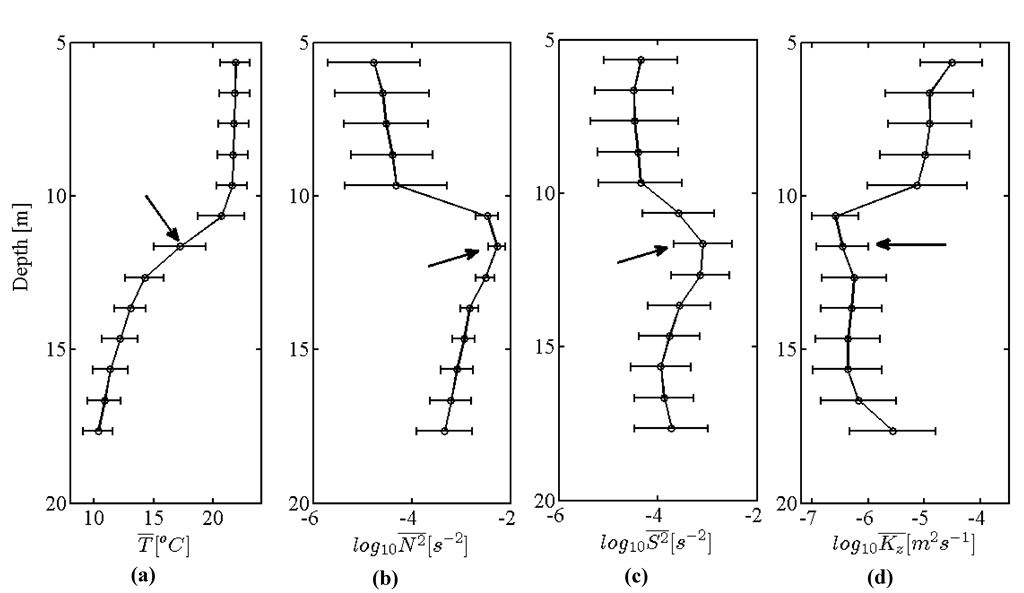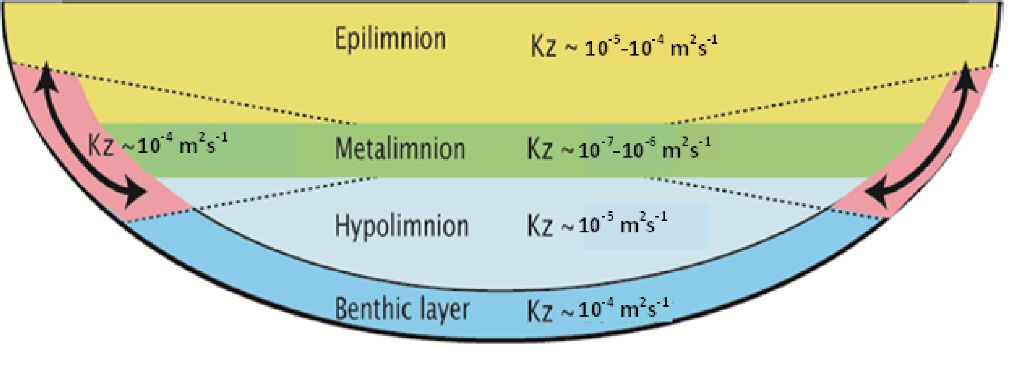|
Project Focus
Spatio-temporal variability and environmental implicaitons of diapycnal mixing in Lake Simcoe
Background and Motivation
Quantifying
the extent of diapycnal mixing (Kz) in the water column of a lake has significant
environmental implications. For
example, the turbulent transport rate of DO from the well-oxygenated epilimnion
to the hypolimnion is controlled by the magnitude of diapycnal mixing rates (Kz). During
periods of strong stratification, the thermocline can act as a barrier to the
vertical turbulent transport of DO from the surface waters and increase the
likelihood of low DO in the hypolimnion.
Lake Simcoe is a large dimictic lake located in
the province of Ontario, Canada and has a history of significant hypolimnetic
DO depletion during the strongly stratified summer season. The contribution of the turbulent DO
fluxes across the thermocline in the hypolimnetic DO levels in the lake has not been explored in detail. In addition, the spatio-temporal variability of Kz as a function of the external environmental forcing in any stratified lake has
not been studied in great detail. A number of studies quantified Kz
in other North American lakes. However, most of these studies rarely exceeded a
few days in duration. The main driving force for the diapycnal mixing in Lake Simcoe
during summer stratification is from vertical shear due to the wind forcing. Thus,
Kz is expected to
correlate with the dimensionless Lake number (LN), which quantifies the relative
strength of the wind forcing in relation to the stratification.
The main objectives of this study were as follows:
1) To examine
the spatial and temporal variability of Kz in
the stratified water columns of Lake Simcoe,
2) To relate the Kz variability with the environmental forcing through
the Lake number LN, and
3) To
determine the contribution of turbulence transport
of DO across the thermocline on the hypolimnetic DO budget.
Methods
- The project was mainly based on a 40-day long field study in late summer of 2011. In this field study, high-sampling frequency
records of water currents and temperature profiles were acquired using a moored acoustic Doppler
current profiler (ADCP) and a chain of fast-response temperature loggers
respectively.
- The acquired data were processed to quantify the relative
strengths of the stratification in relation to the velocity shear, expressed by the dimensionless gradient Richardson number (Rig). The
calculated Rig was used as a proxy to estimate Kz
from a Rig-based Kz
model, recently prooposed for the ocean. The model paramters were first
tuned up for the lake, based on temperature microstructure-based Kz measurements.
- Hourly
wind data from a nearby buoy, DO profile data from the Ontario Minstry
of Environment, and long term three-hourly NARR wind data were also
used.
Figure 1. Profiles of mean (a) temperature, (b) buoyancy frequency, (c) current shear, and (c) diapycnal mixing rates.
Values at the thermocline are shown by an
arrow in each figure. Error bars
represent the standard deviation. Cartoon in bottom figure shows Kz values in different layers of stratified waters.
| Figure 2. Variation of Kz in the epilimnion in (b) , the thermocline in (c), and the hypolimnion in (d), with the LN shown in (a). LN-1 vs wind
speed is shown in (e)
| 
Figure 3a. time series of the distribution of dissolved oxygen [DO (mg L-1)] in the water column for April 27 – November 24, 2011. | Figure 3b. variation of depth-averaged epilimnetic and hypolimentic DO
concentration with time |
Key Findings
- Kz exhibited large
spatial and temporal variability. Spatially, the nearly-isothermal epilimnion showed high
values Kz
~10-5-10-4 m2 s-1. Time-averaged
Kz was ~10-6 m2
s-1 and ~10-5
m2 s-1 in the metalimnion and the hypolimnion
respectively. In both regions, there was temporal variability in Kz of as much as one order of
magnitude depending on how energetic the movements of the thermocline were.
Sporadic mixing events at the benthic layer were also observed. The variability
suggests that mixing between the bottom and the surface layers that occurs in
Lake Simcoe is neither frequent nor fully absent, but is mainly episodic in
nature [Fig. 1].
- Hourly mean Kz averaged over the epilimnion, the hypolimnion and the metalimnion correlated with the LN, which mainly dependent on the wind speed and duration, rather than changes in depth of the thermocline [Fig. 2]
- Analysis of the observed Kz variability with DO distributions for an extended period [Fig. 3] suggested that vertical turbulent
transport of dissolved oxygen was 10% of the total oxygen depleted in the
hypolimnion for the observation period. We concluded that at least some of the
observed year-to-year variability of hypolimnetic oxygen depletion could be due
to the variation in turbulent transport of dissolved oxygen across the
thermocline.
Publications
Peer-reviewed journal publicaitons:
- Chowdhury,
M.R., Wells, M., and
Cossu, R.,
(2015). “Observations of the
variablity of
vertical turbulent mixing and environmental implications in Lake
Simcoe”,
Journal of Great Lakes Research,
Elsevier,
in press (available online).
pdf link
- Wells,
M., Cossu, R., Chowdhury,
M.R., and Zhi, J., “Seiches and
thermal variablity in
Lake Simcoe, Ontario, Canada: Implications for the ecology of a large
freshwater lake”. Journal of Great Lakes Research, In preparation.
Presentations:
- Chowdhury,
M. R.*, Wells, M.G., and Cossu, R., (2014).
Observations of the contributions of vertical turbulent mixing on the
dissolved oxygen budget in Lake Simcoe, 57th Annual Conference of the International
Association of Great Lakes Research, May 26-30, McMaster University, Hamilton,
ON, Canada.
- Li, J. Z.*,
Chowdhury, M. R.,
and Wells, M. G., (2014). Determining the influence of shifts in wind
speed and thermal stratification upon mixing regimes in Lake
Simcoe, 57th Annual Conference of the International
Association of Great Lakes Research, May 26-30, McMaster University, Hamilton,
ON, Canada.
- Chowdhury,
M. R.*,
Wells, M.
G., and Cossu, R., (2013). Internal turbulent mixing in the stratified
waters
of Lake Simcoe. 2nd
Biennial
Lake Simcoe Science Forum organized by the Ontario Ministry
of the
Environment, Oct. 29-30,
Kempenfelt Conference Centre, Barrie,
ON, Canada.
- Chowdhury,
M. R.*,
Wells, M.
G., and Cossu, R., (2013). Turbulence in the stratified near-shore
zones of
large lakes is highly episodic. 5th
Canadian Wastewater Management Conference & 48th
Central
Canadian Symposium on Water Quality Research, Mar. 6-8, Hamilton,
ON, Canada.
- Chowdhury,
M. R.*,
(2012).
Episodic internal turbulence mixing in the stratified lake:
observations from
Lake Simcoe, ON, Brewer-Wilson Seminar Series,
Department of Physics -
University of Toronto, November
16,
Canada.
|




